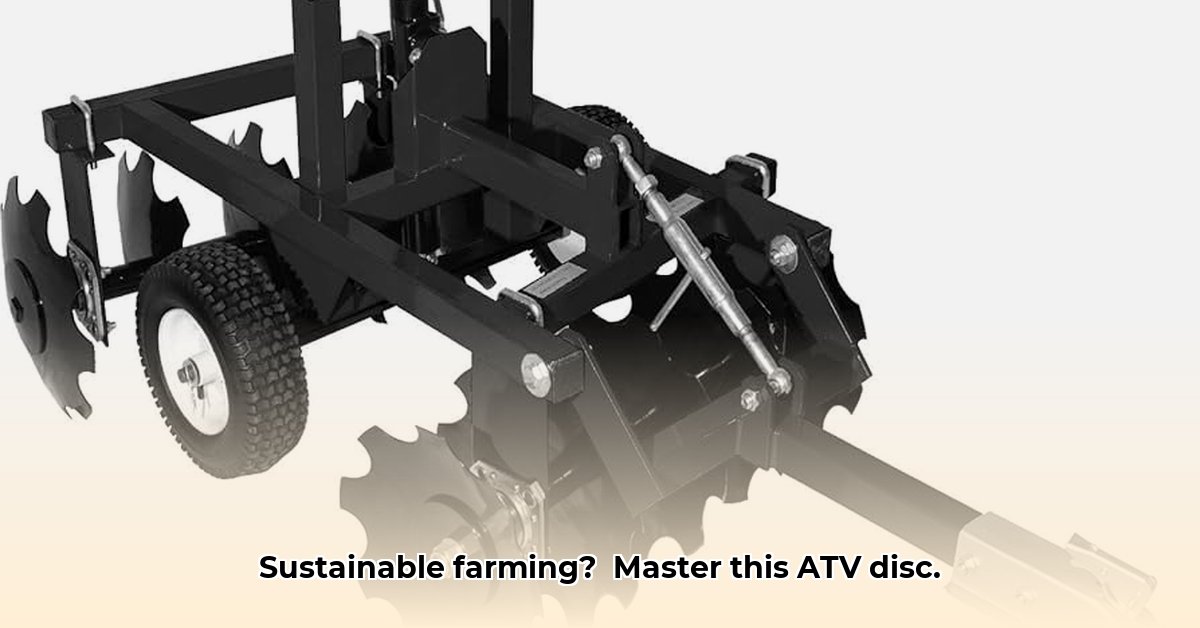
Understanding ATV Disc Harrows and Sustainable Agriculture
Tired of backbreaking labor and inefficient farming practices? An ATV disc harrow can revolutionize your approach to sustainable farming. These versatile tools offer a powerful yet gentle way to prepare your land, minimizing soil disruption and promoting healthier growth. This guide provides a step-by-step approach to effectively using an ATV disc harrow, even for farmers with minimal mechanical experience. We'll cover selection, setup, operation, maintenance, and troubleshooting, emphasizing best practices for sustainable agriculture. For more information on disc harrows, check out this helpful resource.
Why Choose an ATV Disc Harrow? ATV disc harrows excel at breaking up soil, managing weeds, and creating ideal seedbeds. Unlike heavy plowing, they cause minimal soil compaction, fostering healthier soil structure and preserving valuable topsoil. This gentler approach is a cornerstone of sustainable farming, promoting better water retention and nutrient cycling. However, while promising, further research is needed to fully quantify the long-term effects on soil health across diverse soil types and climates.
Choosing the Right ATV Disc Harrow
Selecting the right ATV disc harrow depends on several key factors:
Soil Type:
- Sandy Soils: Require shallower tillage and lighter harrows to prevent excessive soil disruption and water loss.
- Clay Soils: Need heavier-duty harrows for deeper penetration to break up compacted soil. Increased resistance necessitates slower speeds.
- Loamy Soils: Benefit from a moderate approach, balancing tillage depth and harrow weight.
Farm Size:
- Small Farms: A smaller, more compact harrow can be more efficient and maneuverable.
- Larger Farms: A wider working width will increase productivity, but maneuverability might be reduced.
Budget:
Used equipment can offer significant cost savings but requires a thorough inspection for wear and tear. It's important to balance cost with the quality and longevity of the harrow.
Data Gaps: Currently, comprehensive comparisons of different ATV disc harrow models are limited. Further research is needed to formulate model-specific recommendations based on performance and durability.
Preparing and Setting Up Your ATV Disc Harrow
Step 1: Pre-use Inspection: Carefully examine the disc blades for damage, ensuring all bolts and connections are tight and secure. Check the hitch mechanism on both the harrow and your ATV.
Step 2: Safe Attachment: Attach the harrow to your ATV's hitch, following the manufacturer's instructions precisely. Ensure a secure and stable connection.
Step 3: Safety Gear: Always wear appropriate safety gear, including eye protection, sturdy gloves, and closed-toe footwear. Familiarize yourself with your ATV's safety features and operating instructions.
Operating Your ATV Disc Harrow: Best Practices for Sustainable Tillage
Mastering the art of effective operation is key to minimizing soil compaction and maximizing efficiency:
1. Tilling: Overlap passes to ensure complete coverage and avoid skipping areas. Adjust the depth to suit soil conditions; don't overdo it. Shallower, more frequent passes are generally better for soil health.
2. Seedbed Preparation: For seedbeds, aim for a fine tilth (uniformly broken-up soil). Multiple passes may be necessary, adjusting the depth to achieve optimal results.
3. Weed Control: Bury small weeds to prevent their growth. This method works best for young weeds and isn't suitable for deep-rooted or established vegetation.
Data-Backed Question: How much can reducing tillage depth impact soil erosion, especially on slopes? Research suggests significant reductions are possible with appropriate techniques.
Maintenance and Storage: Extending the Lifespan of Your ATV Disc Harrow
Proper care ensures your investment lasts:
1. Cleaning: After each use, remove all soil and debris from the blades and hitch. Wipe it down to prevent rust.
2. Lubrication: Regularly lubricate moving parts according to the manufacturer's instructions. This reduces friction and wear.
3. Storage: Store the harrow in a dry, sheltered area to prevent rust and damage.
Troubleshooting Common Problems
Bent Blades: This usually indicates hitting an obstacle. Repair or replace bent blades to maintain efficiency.
Operational Difficulties: If the harrow is difficult to operate, check for blockages, hitch problems, or worn parts.
Is an ATV Disc Harrow Right for Your Farm?
The suitability of an ATV disc harrow depends on your farm’s specific needs and your land. While offering potential benefits in efficiency and soil health, it's important to consider the current limitations in available data on long-term impacts. Weigh the advantages against the need for further research and remember that ongoing research will provide a more complete picture in the future. However, for small-scale farmers prioritizing sustainability and ease of use, an ATV disc harrow presents a compelling option.